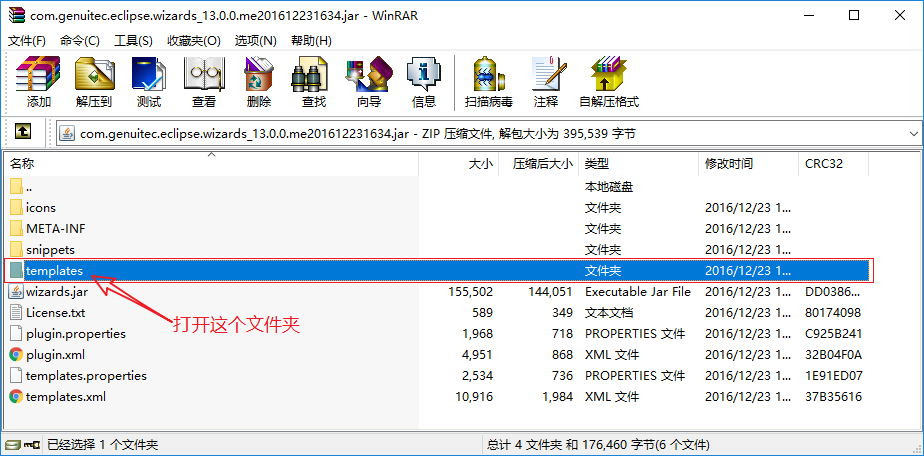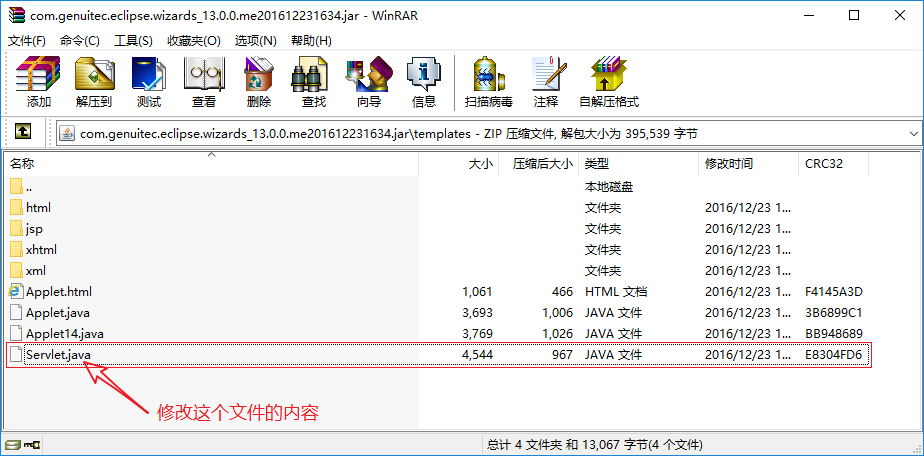myeclipse 2017 CI 中如何修改Servlet模板
在实际开发中,这些生成的代码和注释一般我们都用不到的,每次都要手工删除这些注释和代码,很麻烦,因此可以根据开发的实际情况修改Servlet的模板代码,改成符合实际开发需求的模板代码。
下面以MyEclipse 2017为例进行说明如何修改Servlet的模板代码,具体步骤如下:
找到 MyEclipse 2017 CI 安装目录下的 plugins 文件夹,比如我的:D:learnJavaMyEclipseMyEclipse 2017 CIplugins,然后找到 com.genuitec.eclipse.wizards_13.0.0.me201612231634.jar 这个jar文件,
打开 com.genuitec.eclipse.wizards_13.0.0.me201612231634.jar 这个jar文件后,可以看到里面有一个 templates 文件夹,进入 templates 文件夹,可以看到里面有一个 Servlet.java 文件。
修改里面的代码:删除 doGet 和 doPost 里面的代码和方法注释,在 doPost 方法里面调用 doGet ,这是根据实际情况修改成的模板代码,修改好之后,保存,重启 MyEclipse 2017 CI,使用MyEclipse创建Servlet,此时就是用刚才修改过的模板进行生成了。
(注意:在 MyEclipse 10 安装目录下的 Commonplugins文件夹 ,注意文件夹的不同哦!)
<aw:import> 表示的是要导入的包,
<aw:parentClass> 表示该servlet继承的父类,
<aw:constructor 表示的是构造器,
<aw:method 表示的是方法的声明,
新的 Servlet.java 文件中的内容如下:
#---------------------------------------------# # <aw:description>Template for Servlet</aw:description> # <aw:version>1.1</aw:version> # <aw:date>04/05/2003</aw:date> # <aw:author>Ferret Renaud</aw:author> #---------------------------------------------# <aw:import>java.io.IOException</aw:import> <aw:import>java.io.PrintWriter</aw:import> <aw:import>javax.servlet.ServletException</aw:import> <aw:import>javax.servlet.http.HttpServlet</aw:import> <aw:import>javax.servlet.http.HttpServletRequest</aw:import> <aw:import>javax.servlet.http.HttpServletResponse</aw:import> <aw:parentClass>javax.servlet.http.HttpServlet</aw:parentClass> <aw:constructor name="c1"> public <aw:className/>() { super(); } </aw:constructor> <aw:method name="doGet"> public void doGet(HttpServletRequest request, HttpServletResponse response) throws ServletException, IOException { } </aw:method> <aw:method name="doPost"> public void doPost(HttpServletRequest request, HttpServletResponse response) throws ServletException, IOException { doGet(request,response); } </aw:method>
示例 XxxServlet.java 文件

1 package com.itheima.product.web.servlet; 2 3 import java.io.IOException; 4 5 import javax.servlet.ServletException; 6 import javax.servlet.http.HttpServlet; 7 import javax.servlet.http.HttpServletRequest; 8 import javax.servlet.http.HttpServletResponse; 9 10 public class PayOnlineServlet extends HttpServlet { 11 12 @Override 13 public void doGet(HttpServletRequest request, HttpServletResponse response) throws ServletException, IOException { 14 15 } 16 17 @Override 18 public void doPost(HttpServletRequest request, HttpServletResponse response) throws ServletException, IOException { 19 doGet(request, response); 20 } 21 22 }
附上:旧的 Servlet.java 文件中的内容如下:
#---------------------------------------------# # <aw:description>Template for Servlet</aw:description> # <aw:version>1.1</aw:version> # <aw:date>04/05/2003</aw:date> # <aw:author>Ferret Renaud</aw:author> #---------------------------------------------# <aw:import>java.io.IOException</aw:import> <aw:import>java.io.PrintWriter</aw:import> <aw:import>javax.servlet.ServletException</aw:import> <aw:import>javax.servlet.http.HttpServlet</aw:import> <aw:import>javax.servlet.http.HttpServletRequest</aw:import> <aw:import>javax.servlet.http.HttpServletResponse</aw:import> <aw:parentClass>javax.servlet.http.HttpServlet</aw:parentClass> <aw:constructor name="c1"> /** * Constructor of the object. */ public <aw:className/>() { super(); } </aw:constructor> <aw:method name="doGet"> /** * The doGet method of the servlet. <br> * * This method is called when a form has its tag value method equals to get. * * @param request the request send by the client to the server * @param response the response send by the server to the client * @throws ServletException if an error occurred * @throws IOException if an error occurred */ public void doGet(HttpServletRequest request, HttpServletResponse response) throws ServletException, IOException { response.setContentType("text/html"); PrintWriter out = response.getWriter(); out.println( "<!DOCTYPE HTML PUBLIC "-//W3C//DTD HTML 4.01 Transitional//EN">"); out.println("<HTML>"); out.println(" <HEAD><TITLE>A Servlet</TITLE></HEAD>"); out.println(" <BODY>"); out.print(" This is "); out.print(this.getClass()); out.println(", using the GET method"); out.println(" </BODY>"); out.println("</HTML>"); out.flush(); out.close(); } </aw:method> <aw:method name="doPost"> /** * The doPost method of the servlet. <br> * * This method is called when a form has its tag value method equals to post. * * @param request the request send by the client to the server * @param response the response send by the server to the client * @throws ServletException if an error occurred * @throws IOException if an error occurred */ public void doPost(HttpServletRequest request, HttpServletResponse response) throws ServletException, IOException { response.setContentType("text/html"); PrintWriter out = response.getWriter(); out.println( "<!DOCTYPE HTML PUBLIC "-//W3C//DTD HTML 4.01 Transitional//EN">"); out.println("<HTML>"); out.println(" <HEAD><TITLE>A Servlet</TITLE></HEAD>"); out.println(" <BODY>"); out.print(" This is "); out.print(this.getClass()); out.println(", using the POST method"); out.println(" </BODY>"); out.println("</HTML>"); out.flush(); out.close(); } </aw:method> <aw:method name="doPut"> /** * The doPut method of the servlet. <br> * * This method is called when a HTTP put request is received. * * @param request the request send by the client to the server * @param response the response send by the server to the client * @throws ServletException if an error occurred * @throws IOException if an error occurred */ public void doPut(HttpServletRequest request, HttpServletResponse response) throws ServletException, IOException { // Put your code here } </aw:method> <aw:method name="doDelete"> /** * The doDelete method of the servlet. <br> * * This method is called when a HTTP delete request is received. * * @param request the request send by the client to the server * @param response the response send by the server to the client * @throws ServletException if an error occurred * @throws IOException if an error occurred */ public void doDelete(HttpServletRequest request, HttpServletResponse response) throws ServletException, IOException { // Put your code here } </aw:method> <aw:method name="init"> /** * Initialization of the servlet. <br> * * @throws ServletException if an error occurs */ public void init() throws ServletException { // Put your code here } </aw:method> <aw:method name="destroy"> /** * Destruction of the servlet. <br> */ public void destroy() { super.destroy(); // Just puts "destroy" string in log // Put your code here } </aw:method> <aw:method name="getServletInfo"> /** * Returns information about the servlet, such as * author, version, and copyright. * * @return String information about this servlet */ public String getServletInfo() { return "This is my default servlet created by Eclipse"; } </aw:method>
具体操作如下图所示:



